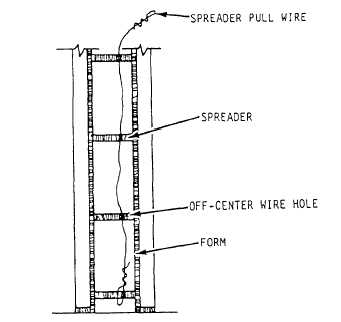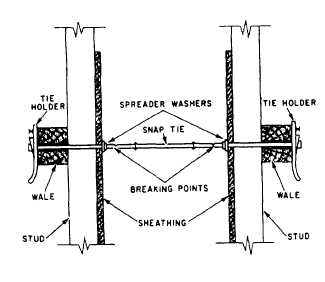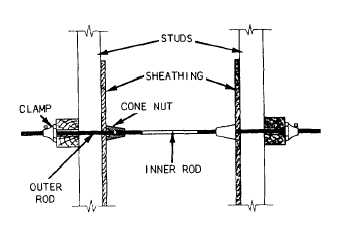
Figure 7-10.-Removing wood spreaders.
Wire ties and wooden spreaders have been largely replaced by various manufactured devices in which the function of the tie and the function of the spreader are combined. Figure 7-11 shows one of these. It is called a snap tie. These ties are made in various sizes to tit various wall thicknesses. The tie holders can be removed from the tie rod. The rod goes through small holes bored in the sheathing, and also through the wales, which are usually doubled for that purpose. Tapping the tie holders down on the ends of the rod brings the sheathing to bear solidly against the spreader washers. You can prevent the tie holder from coming loose by driving a duplex nail in the provided hole. After the concrete has hardened, the tie holders can be detached to strip the forms. After the forms are stripped, a special wrench is used to break off the outer sections of rods. The rods break off at the breaking points, located about 1-inch inside the surface of the concrete. Small surface holes remain, which can be plugged with grout if necessary.
Another type of wall-form tie is the tie rod (figure 7-12). This rod consists of an inner section that is threaded on both ends and two threaded outer sections. The inner section with the cone nuts set to the thickness of the wall is placed between the forms, and the outer sections are passed through the wales and sheathing and threaded into the cone nuts. The clamps are then threaded on the outer sections to bring the forms to bear against the cone nuts. After the concrete hardens, the clamps are loosened, and the outer sections of rod are removed by threading them out of the cone nuts. After the forms are stripped, the cone nuts are removed from the concrete by threading them off the inner sections of the rod with a special wrench. The cone-shaped surface holes that remain can be plugged with grout. The inner sections of the rod remain in the concrete. The outer sections and the cone nuts may be reused indefinitely.
Wall forms are usually constructed as separate panels. Make the panels by first nailing sheathing to the studs. Next, connect the panels, as shown in

Figure 7-11.-Snap tie.

Figure 7-12.-Tie rod.
Continue Reading